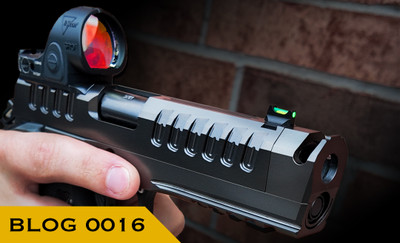


The 1911 pistol is an iconic firearm renowned for its precision and power. However, mastering its accuracy requires a solid understanding of its mechanics and proper shooting techniques. Whether you’re a seasoned shooter or a beginner, focusing on your grip, trigger, and sights during practice will help unlock the full potential of the 1911 and enhance range performance.
A proper grip is the foundation of accurate shooting. The 1911 has a welcoming frame angle that naturally lends itself to a secure hold, but the key is consistency. Ensure your strong hand is high on the backstrap, but not so high as to affect the index finger. It is critical that the index finger does not rub or drag against the frame, which sometimes happens with too high of a grip. Point the thumb forward and placed on top of the mechanical safety. The fingers should wrap firmly around the grip, applying pressure from the pinkies. The weak hand should wrap around the strong hand, with both thumbs aligned along the frame. Apply firm and consistent grip pressure through firing. This grip minimizes recoil and keeps the pistol steady.
Trigger control is critical for precise shooting with the 1911. Its single-action trigger is known for its crisp break, but improper technique can lead to flinching or pulling shots off target. Press the trigger straight back, avoiding any lateral movement. The amount of trigger finger to place will depend on the size of the hands. Too much in either direction can cause the finger to rub on the edge of the trigger. This will impart movement to the sights before the shot is fired and must be avoided. Practice dry firing to develop a smooth, controlled press. Remember, consistency is key—press the trigger the same way every time.
The 1911’s iron sights vary by model, but most feature a notch-and-post setup. Align the front sight within the rear notch, ensuring the top of the sights forms a straight line. Focus on the front sight, as this is where precision begins. Avoid the temptation to look at the target instead of the sights. If your 1911 has upgraded sights, such as fiber optics or night sights, take advantage of these enhancements to improve visibility and alignment. If you are running a red dot sight, the procedure is different. Focus on the target with both eyes open. Think of the target as the front sight post and the sight’s window as the rear notch. Regular practice is the ultimate key to improvement. Putting in the time and effort will pay dividends. Mix live fire, dry fire, and drills to build proficiency. Incorporate timed exercises to simulate real-world scenarios and seek feedback from experienced shooters or instructors to refine technique.
By applying these tips and dedicating time to practice, the accuracy and performance with the 1911 with be dramatically increased. With its inherent precision and improved skills, confidence grows and there is a certain level of satisfaction from mastering this timeless classic.